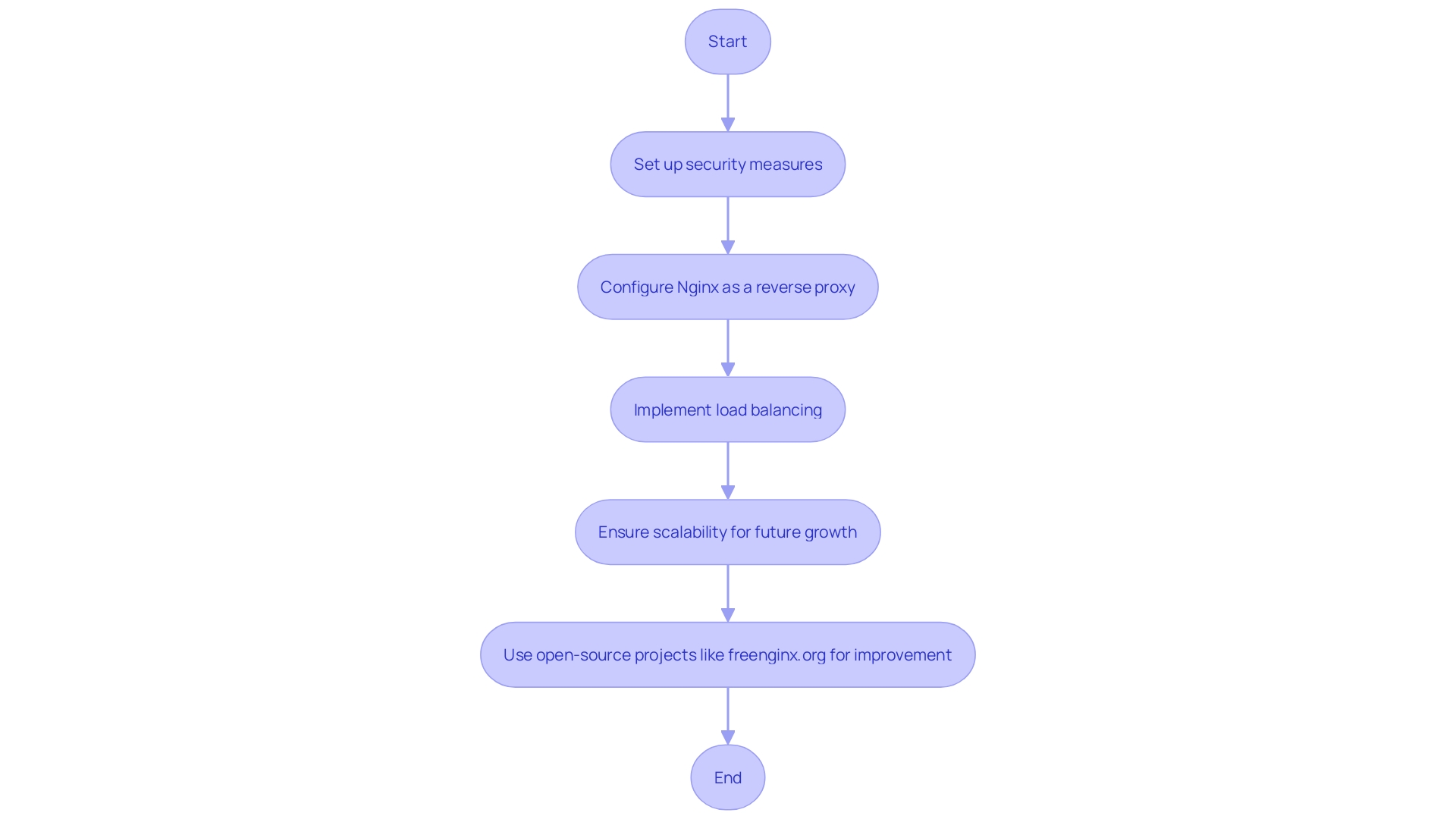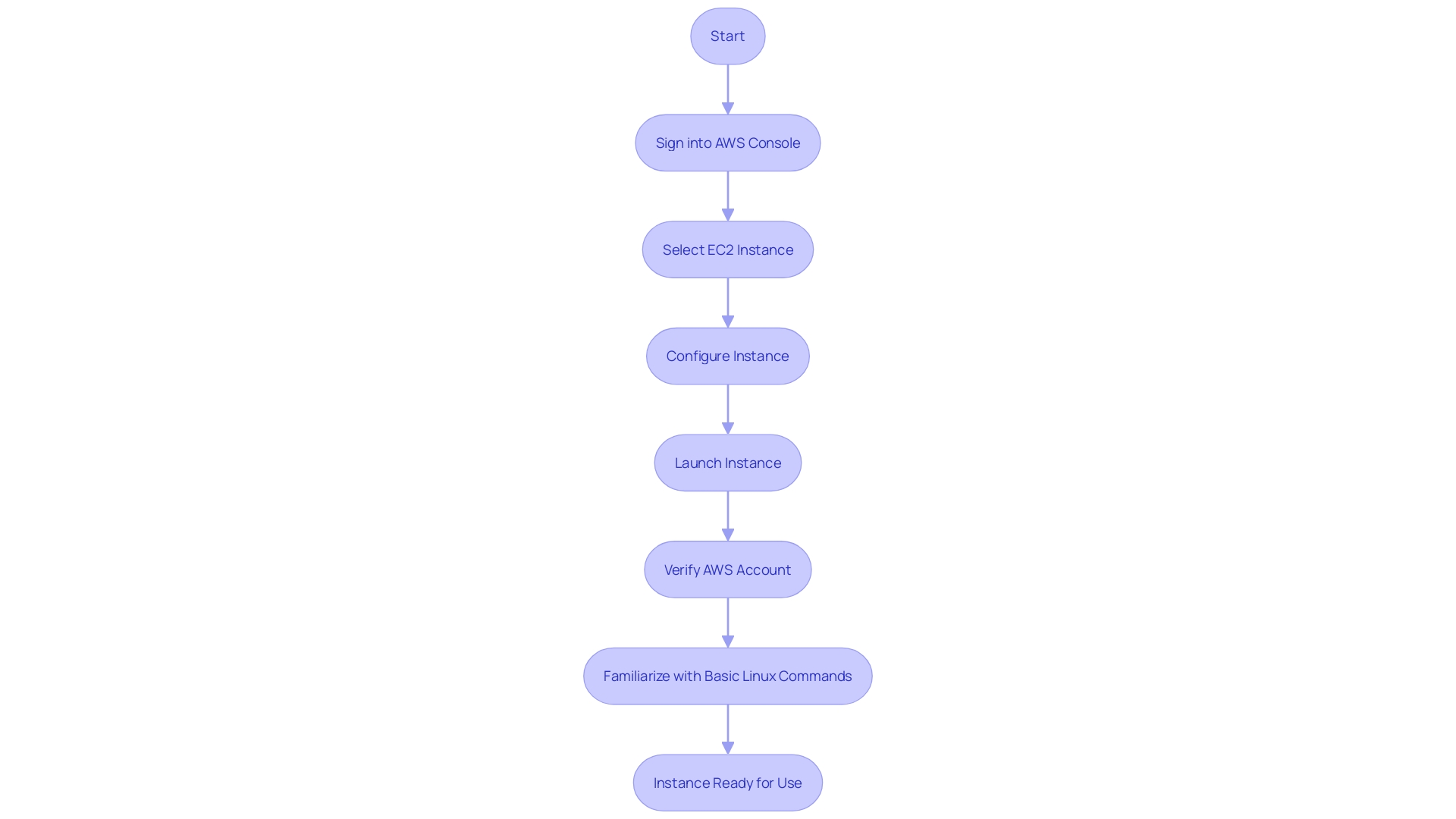Introduction
Amazon Web Services (AWS) has established itself as a leading cloud computing platform, offering a wide range of hosting services tailored to the evolving needs of websites and applications. With its reputation for scalability, AWS has become the go-to choice for businesses like Dunelm Group plc and GoDaddy, who rely on its robust infrastructure to support millions of users and generate substantial revenue. AWS's serverless offerings, such as AWS Lambda, have revolutionized the cloud services landscape by providing scalable solutions that eliminate the need for managing underlying servers.
This article will guide you through the process of deploying a web server on AWS, covering everything from setting up your environment to configuring security measures, choosing the right operating system and instance type, installing and configuring a web server, deploying your web application, implementing load balancing and auto-scaling, monitoring and managing your web server, and even exploring alternative options like hosting static websites on Amazon S3. Troubleshooting common issues and AWS's support resources will also be addressed. By following these steps, you'll be equipped to leverage AWS's expertise and reliability to establish a secure, scalable, and high-performing web hosting environment for your digital endeavors.
Why Choose AWS for Web Hosting
Amazon Web Services (AWS) has solidified its position as a premier cloud computing platform by providing a diverse suite of hosting services that cater to the dynamic needs of websites and applications. Renowned for its scalability, AWS enables businesses like Dunelm Group plc, the UK's leading homewares retailer, to support over 400 million sessions annually on their digital platform, crucial for generating around 35% of their revenue. AWS's infrastructure is adept at accommodating growth, offering microservices architectures that support distributed systems, which is particularly beneficial for content-rich, interactive client-side applications.
For companies like GoDaddy, which serves over 20 million customers globally, the pursuit of data-driven decision-making and customer satisfaction is paramount. AWS aligns with such goals by offering a robust and secure environment for batch processing optimization, which can be critical for enhancing efficiency and managing workloads effectively. Furthermore, AWS's commitment to providing industry-premium services at competitive prices resonates well with GoDaddy's approach to improvement opportunities, ensuring that customers' online presence is both powerful and cost-effective.
Understanding the essence of web hosting is fundamental for any business aiming to establish a strong online presence. It is akin to leasing a digital storefront for your company, allowing you to showcase products, share information, and engage with consumers. AWS's serverless offerings, like AWS Lambda, exemplify the evolution of cloud services, offering scalable solutions that efficiently respond to user requests without the need for managing underlying servers. This paradigm shift has been critical for businesses seeking agile and resilient web applications capable of adapting to the internet's evolving landscape.
Ultimately, selecting a hosting service like AWS equips you with a virtual infrastructure that not only meets your current requirements but also anticipates future needs, ensuring that your digital endeavors are built on a foundation of reliability and innovation.
Prerequisites for Deploying a Web Server on AWS
Venturing into the realm of Amazon Web Services (AWS) for web server deployment requires a foundational setup and some groundwork knowledge. To initiate, an AWS account is imperative; if you are yet to own one, registration is straightforward on the AWS platform. Beyond account setup, a grasp of web server dynamics, network principles, and the AWS Management Console is beneficial.
AWS stands as the titan of cloud services, offering over 300 cloud solutions including compute, storage, databases, and analytics. These services cater to complex application deployment, development, and management, providing scalable and on-demand IT resources via the Internet. With AWS, businesses and individuals can sidestep the hefty investments associated with maintaining physical infrastructure.
Diving into AWS's extensive service offerings, you will find options such as virtual machines, serverless computing, and container orchestration through services like Kubernetes. AWS's robust security infrastructure ensures data confidentiality, allowing organizations to concentrate on business growth. The platform's extensive documentation and learning resources bolster the learning curve for novices and deepen the expertise of seasoned users.
As you embark on this AWS journey, Canalys, an independent analyst company, underscores the significance of smart market insights and the necessity for IT professionals to adapt beyond traditional business models, advocating the importance of high-quality data and innovative technology use.
In summary, before launching your web server on AWS, ensure you have an active AWS account and familiarize yourself with the necessary technical concepts. By doing so, you are setting the stage for a successful and secure deployment in the ever-evolving cloud and cybersecurity landscapes.
Step 1: Signing in to Your AWS Account and Setting Up the Environment
Deploying a web server on Amazon Web Services (AWS) begins with establishing your AWS environment. To do this, access the AWS Management Console with your credentials and explore the AWS services dashboard. This is the gateway to harnessing the robust AWS infrastructure, known for its security and scalability, which underpins the digital platforms of leading businesses like Dunelm and GoDaddy.
Dunelm's digital platform benefits from AWS's capabilities, handling over 400 million sessions annually and contributing significantly to their revenue. Similarly, GoDaddy leverages AWS to enhance their data-driven approach, optimizing batch processing jobs to achieve efficiency. These cases exemplify the strategic value of AWS in scaling operations and maintaining customer satisfaction.
Furthermore, AWS's commitment to innovation is evident in their plans to invest heavily in the UK's digital economy, strengthening their infrastructure to support advanced AI models and meet customer demands. This solidifies AWS as a pivotal player in cloud computing, despite the scrutiny from regulatory bodies.
When migrating single-page applications to the cloud, AWS presents a technically neutral environment, enabling the use of any framework for frontend assets and any programming language for the backend that interfaces through a REST API.
Beginning your AWS journey requires a free AWS account. After creating one, log in as the root user, navigate to the 'Services' section, and select 'EC2' under 'Compute' to launch your instance. This process is your first step towards leveraging the AWS framework, which offers flexible pricing and a global reach, streamlining the development and scaling of applications.

Step 2: Creating an EC2 Instance for Your Web Server
Amazon Web Services (AWS) provides a robust cloud platform with an extensive array of services, among which Amazon EC2 (Elastic Compute Cloud) stands out for its scalable computing resources. Beginning the journey of setting up an EC2 instance involves a few critical steps that are essential for running your applications in the cloud. Accessing the AWS Management Console, you will search for and select the EC2 service, navigating to the instance creation area.
The initial phase requires you to choose an Amazon Machine Image (AMI), which determines the operating system and configuration of your virtual server. For those new to AWS, a free tier-eligible AMI is often an optimal choice, allowing you to take advantage of AWS offerings without immediate costs, provided your account is within its first year of service. It is vital to understand the free tier policy thoroughly before proceeding to ensure you remain within the usage limits.
Following the selection of an appropriate AMI, you will then specify the instance type, balancing the required CPU, memory, storage, and networking capabilities with cost considerations. The ability to remotely access your assets from anywhere in the world and the 'Pay-As-You-Use' pricing model underscore the flexibility and cost-effectiveness of AWS solutions.
Amazon's commitment to security cannot be overstated, with a multi-layered infrastructure that safeguards data privacy. As you configure your EC2 instance, security settings are among the most critical considerations, ensuring that your computing environment remains secure from potential threats.
By understanding each step of the setup process, from logging into the AWS console to configuring your EC2 instance, you can leverage the full power of AWS EC2 to provide the necessary computing resources for your applications, all while maintaining a keen eye on security and cost management. This meticulous approach not only enables efficient cloud operations but also aligns with the strategies of data-driven entities like GoDaddy, which serves over 20 million customers by harnessing insights from data to fuel business decisions and optimize operations.
Step 3: Choosing the Right Operating System and Instance Type
Selecting the appropriate infrastructure for your web server deployment on Amazon Web Services (AWS) is crucial to achieving optimal performance and security. AWS provides an expansive cloud computing platform, renowned for its flexibility and affordability, which allows businesses to scale operations as needed. When configuring your AWS environment, choosing the right operating system is pivotal, as it should align with the technology stack and the specific needs of your applications. Moreover, it is essential to pick an instance type that addresses the expected workload and performance requirements of your web server. With AWS's secure infrastructure, organizations benefit from multiple layers of data protection that support a focus on business development without compromising on data privacy. For example, companies like GoDaddy leverage AWS to optimize their batch processing jobs, demonstrating the practical application of AWS's secure and scalable environment in supporting large-scale operations and improving efficiency.
Step 4: Configuring Security Groups and Networking
In configuring your AWS EC2 instances, it's critical to establish robust security measures to safeguard your web server against unauthorized access and potential threats. Security groups serve as the first line of defense, functioning as virtual firewalls that meticulously dictate both the incoming and outgoing traffic. By meticulously crafting the appropriate rules within these security groups, you can create a secure channel for traffic to flow to and from your web server.
Additionally, the comparison of security groups to network access control lists (NACLs) highlights the granular control they offer at the instance level, contrasted with NACLs that operate at the subnet level, providing an additional layer of traffic filtering. The dynamic nature of cloud security necessitates a continuous evaluation and application of AWS best practices. This includes a thorough understanding of the roles played by various components such as VPCs, security groups, and NACLs in creating a resilient infrastructure.
Implementing strong identity and access management (IAM) practices further underpins the security framework, ensuring that permissions are tightly regulated based on the principle of least privilege. This approach is echoed by AWS's commitment to security, as stated by AWS's own security culture which emphasizes the integration of security into every aspect of their service development. By prioritizing security from the outset, AWS has established a trusted platform for organizations to run their mission-critical applications and handle sensitive data.
Moreover, the importance of responsible disclosure in the context of zero-day vulnerabilities cannot be overstated. AWS's exemplary response to such disclosures further reinforces the platform's dedication to security. This proactive stance on security is critical in the face of evolving cyber threats, as evidenced by recent incidents highlighted in the news. By staying informed and adapting to the latest security practices, organizations can ensure their AWS infrastructure remains secure and resilient against potential cyber threats.
Step 5: Installing and Configuring a Web Server (e.g., Nginx)
With your Amazon EC2 instance ready and security measures in place, you're set to embark on the next step: deploying a web server. Among the sea of web servers, Nginx stands out for its exceptional performance and scalability, proving itself as a powerhouse in serving web content efficiently. Its capabilities are not limited to straightforward content delivery; Nginx can also skillfully handle more complex tasks such as reverse proxy, which is the art of directing client requests to various backend servers, and load balancing, which ensures smooth traffic flow across your server infrastructure.
To get started, dive into the comprehensive guides available that will walk you through setting up your own Nginx server. These resources are designed to illuminate the process, whether you're looking to deploy a simple website or configure Nginx as a reverse proxy for a more intricate architecture. As you implement Nginx, consider its role in the larger context of data centers and web hosting. The industry's push towards efficiency underscores the importance of a server's scalability and its ability to adapt to the ever-increasing demands of internet traffic, which witnessed a 25% growth globally, echoing the significance of robust server solutions.
Moreover, embracing open-source projects like freenginx.org can ensure that your web server technology progresses without the constraints of corporate interests. As you configure your Nginx server, remember that the technology you deploy today should not only meet your current needs but also anticipate the scalability required for future growth, all while maintaining high performance and stability.

Step 6: Deploying Your Web Application
Deploying a web application on Amazon Web Services (AWS) is more than just uploading code; it's about leveraging a robust and secure cloud infrastructure. Once your AWS EC2 instance is configured, it's time to transfer your application code and necessary files. This pivotal step often involves setting up additional components like databases, which AWS simplifies with its comprehensive service offerings, including relational databases (RDS) and NoSQL databases (DynamoDB).
AWS is renowned for its scalability and security, critical for any data-driven company. EC2 instances can be scaled easily to accommodate varying traffic, and the expansive security measures provided by AWS ensure data privacy through a layered surveillance approach. This infrastructure is backed by extensive documentation, which aids in both initial setup and advanced configuration.
For instance, deploying applications like the OWASP Juice Shop on AWS ECS can serve as an immersive learning experience, covering vital aspects of application deployment and security. This hands-on approach is beneficial for professionals across various disciplines, from cybersecurity to cloud computing.
Moreover, AWS's market leadership and vast array of services, like VPC for networking, ECS for container services, and IAM for security, make it an invaluable platform for hosting web applications. Notably, the freenginx. Org project underscores the importance of community contributions in maintaining the openness of web server technologies, aligning with the ethos of continuous learning and development that AWS supports.
In essence, when deploying your web application on AWS, you're not just setting up a digital space, but also investing in a secure, scalable, and educational journey through the cloud.
Step 7: Setting Up Load Balancing and Auto-Scaling (Optional)
To cater to the demands of an ever-connected world, where customers expect round-the-clock availability, your web hosting infrastructure must be robust and resilient. Implementing load balancing is akin to efficiently managing a busy restaurant through a team of waiters, ensuring that each patron receives prompt attention, thereby maximizing satisfaction and service quality. Similarly, in the digital realm, load balancing plays a pivotal role by evenly distributing incoming traffic across multiple EC2 instances, preventing any single server from becoming a bottleneck.
Complementing load balancing, auto-scaling is the technological equivalent of dynamically adjusting the number of waiters based on the number of guests; it automatically scales the count of EC2 instances up or down in response to fluctuations in demand. This duo of features not only enhances the performance of your web servers but also fortifies their availability, safeguarding against potential disruptions and preserving the integrity of business operations. In essence, by embracing these technologies, organizations maintain a seamless online presence, which is paramount for customer retention and business continuity.

Step 8: Monitoring and Managing Your Web Server
For professionals managing web servers, proactive monitoring is not just an option; it is a necessity. AWS offers a suite of tools designed to maintain peak performance and security of your digital infrastructure. Among these, AWS CloudWatch stands out as a robust, fully managed monitoring service that keeps a vigilant eye on your AWS resources and applications. It is adept at collecting, analyzing, and visualizing a wide array of metrics, logs, and events.
Moreover, AWS Systems Manager presents an invaluable opportunity to automate administrative tasks, streamlining the management of your EC2 instances and other AWS resources. This level of automation is critical in ensuring continuous operational efficiency and can help prevent potential performance hiccups or security lapses.
Integration into AWS's ecosystem doesn't end there. Services like AWS X-Ray provide deep insights into your applications, allowing full observability of logs, metrics, and traces. This transparency is vital for maintaining system integrity and addressing issues before they escalate. AWS also offers training to ensure your team is well-versed in leveraging these tools for optimal observability.
But AWS's commitment to your infrastructure's health goes beyond internal tools. The Route 53 service offers Health Checks, enabling you to ensure that your site remains accessible at all times—a critical component of any online presence.
The seamless integration of these AWS services fulfills a comprehensive monitoring and logging strategy, providing the insights required to keep your systems resilient and secure. With AWS, you have the capability to create custom dashboards, set up sophisticated alarms, and utilize anomaly detection, all while adhering to compliance and security standards.
In essence, the AWS suite arms you with the necessary tools to monitor your web server's performance meticulously, manage your resources efficiently, and ultimately protect your business operations from potential threats.
Alternative: Hosting Static Websites on Amazon S3
Leveraging Amazon Web Services (AWS) for hosting static websites offers a straightforward and efficient solution. AWS's Simple Storage Service (S3) provides an optimal platform for static site hosting. With S3, developers can store their site's static files—such as HTML, CSS, and JavaScript—and serve them directly to users without the need for a traditional web server.
The process begins by uploading the website's static content to an S3 bucket. Once stored, configuring the S3 bucket for web hosting is a matter of setting the appropriate permissions and enabling the static website hosting option. This ensures that the files are publicly accessible and that the S3 bucket can respond to web requests.
For example, 0000.quest, a static website hosted on AWS, illustrates the seamless integration of S3 with other AWS services, such as Route 53 for DNS management and CloudFront for content delivery. By utilizing AWS's ecosystem, web developers can create a robust static website with global reach and high availability.
As noted in Cloudflare's 2023 Year in Review, the Internet is experiencing significant growth, with global traffic increasing by 25%. This trend underscores the importance of using a reliable and scalable hosting solution like AWS. With its distributed architecture, AWS can handle traffic spikes and ensure consistent website performance, which is critical as more users come online and demand faster, more secure access to web content.
The choice to use AWS for a static website not only provides the benefits of a leading cloud infrastructure but also aligns with the current trajectory of digital services. Amazon, a pioneer in cloud computing, has seen its stock price and earnings soar, reflecting the company's innovation and dominance in the tech industry, including its web hosting solutions.
In summary, hosting a static website on AWS S3 is a cost-effective and scalable choice. This approach is bolstered by data indicating the relentless expansion of Internet traffic and the necessity for reliable and efficient web hosting services that can adapt to the evolving digital landscape.
Troubleshooting Common Issues
When utilizing Amazon Web Services (AWS) for web hosting, particularly for applications like WordPress, the task can be quite technical and may introduce some common challenges. These challenges range from connectivity disruptions to misconfiguration of services and performance bottlenecks. To address such issues, AWS has put together comprehensive documentation and support systems designed to assist users in navigating and overcoming these potential obstacles.
Launching an AWS instance, for example, is a foundational step. Users typically start by signing into the AWS console and selecting an EC2 instance from the Compute section. From there, they proceed to configure and launch the instance. This process requires a verified AWS account and, ideally, some familiarity with basic Linux commands to navigate the server environment.
Maintenance and upgrades are critical in AWS-hosted environments, especially when dealing with WordPress setups containing Personal Identifiable Information (PII). The migration of WordPress to AWS Lightsail, for instance, simplifies maintenance and upgrades, ensuring that the platform remains secure and updated with ease.
AWS's global reach and segmented availability zones offer customers the flexibility to scale their services geographically as needed. With a pay-as-you-go pricing model, businesses can adjust their usage without long-term commitments, tapping into AWS's efficient migration services for a smooth transition to the cloud.
Developers are increasingly recognizing the importance of server knowledge, which extends beyond coding to include server and network management. A solid grasp of basic server operations is essential for efficient problem-solving and collaboration with network professionals.
To that end, AWS provides a robust platform for securing web servers, with detailed guides on server hardening, monitoring, and automation. These processes, when standardized, can be replicated across multiple servers to ensure consistent security and management.
For organizations preparing to adopt AWS, the AWS Cloud Adoption Framework stipulates an action plan that includes stakeholder identification, discussions on app usage and pain points, regulatory compliance, and dependency mapping. This framework ensures a comprehensive approach to cloud migration, addressing the complexity of transitioning services and apps to AWS.

Conclusion
AWS has established itself as a leading cloud computing platform, offering scalable hosting services for websites and applications. Businesses like Dunelm Group plc and GoDaddy rely on AWS's robust infrastructure to support millions of users and generate substantial revenue.
AWS's serverless offerings, such as AWS Lambda, have revolutionized the cloud services landscape by providing scalable solutions that eliminate the need for managing underlying servers. This paradigm shift has been critical for businesses seeking agile and resilient web applications capable of adapting to the internet's evolving landscape.
Deploying a web server on AWS requires a foundational setup and familiarity with the necessary technical concepts. By establishing an AWS environment, creating an EC2 instance, configuring security measures, and choosing the right operating system and instance type, you can ensure a successful and secure deployment.
Installing and configuring a web server, such as Nginx, is crucial for efficient content delivery and scalability. By leveraging load balancing and auto-scaling, you enhance the performance and availability of your web servers, ensuring a seamless online presence.
Monitoring and managing your web server is essential for maintaining peak performance and security. AWS provides tools like AWS CloudWatch and AWS Systems Manager to automate administrative tasks and gain insights into your applications, ensuring a resilient and secure infrastructure.
For those looking for an alternative option, hosting static websites on Amazon S3 provides a cost-effective and scalable solution. By leveraging AWS's Simple Storage Service (S3), you can store and serve static files directly to users without the need for a traditional web server.
In conclusion, deploying a web server on AWS equips you with a secure, scalable, and high-performing web hosting environment. By following the steps outlined in this article and leveraging AWS's expertise and reliability, you can establish a strong online presence for your digital endeavors.




